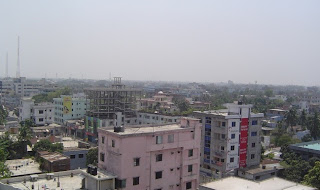Qazi Rukn al-Din Samarkandi was a profound scholar in Islamic
learning. He was of Persian origin and a Qazi of Lakhnawati in the time of
‘Ala al-Din ‘Ali Mardan Khalji. His translation of the Sanskrit
book Amritkund on yogic system first in Persian and then into Arabic
proves his proficiency in both of the languages, and bears witness to their
study at the initial period of the Muslim rule in Bengal.
In
this chain stands Imamzadah Jalal al-Din son of Jamal al-Din who
delivered lectures on Islamic disciplines in the court of Ghiyath al-Din
Iwaz Khalji (1212-1227 A.C). Jalal al-Din, a profound scholar in
Arabic and Islamics happened to be an inhabitant of Firuz kuh in Persia.
These facts lead to substantiate the case for the cultivation of Arabic and
Persian learning under the state patronization even at the initial period of
Muslim rule in Bengal.
Pertinently
it may also be mentioned here that the administration of the country was to be
run according to the Shariah. The Diwan al-Qaza or the Department
of Justice testifies to the fact that administration of Bengal Sultanate
like other Muslim countries was being run broadly on the basis of the Shariah.
The sources of Muslim law are four i.e. Al-Quran, Al-Hadith, Ijma
and Qiyas. The persons in charge of the department of justice and other
important departments of the government were expected to achieve proficiency in
Arabic to understand properly the implication and interpretation of laws as
embodied in the holy Quran and the Sunnah of the Prophet (Sm).
The
epigraphic records bear witness to this fact that Arabic language was given
importance for a subject of study in this land. The state language being
Persian, the persons employed in the various positions of administrative
hierarchy must have possessed mastery in Persian language. Hence it is
reasonable to believe that all possible steps were taken to train up expertise
personnel’s in Arabic and Persian to run the administration of the country
smoothly and in a proper way.
A
cogent question arises that how the personnel’s could be trained up in Islamics
including the language study and what proper arrangement is provided for that
purpose. The answer is simple that establishment of madaris and educational
seminaries could be considered as proper way for realizing the purpose. Both
epigraphic and literary sources recorded a large number of madaris and
educational institutions that sprang up in the capital cities and strategic
places of Bengal during the Sultanate period.
Of
these educational seminaries Taqi al-Din Arabi’s Madrasah at Mahisu
identified with Mahisantosh built in about the middle of the 13th
century A.C., Zafar Khan’s Madrasah at Triveni built in 1313
A.C., Darasbari Madrasah of the time of Shams al-Din Yusuf Shah
(1474-1481 A.C.), Belbari Madrasah of `Ala al-Din Husayn Shah
(1493-1519 A.C.) both situated in Gaur area, Bagha Madrasah of the time
of Nasir al-Din Nusrat Shah (1519-1531 A.C.) and Mawlana Sharf al-Din
Abu Tawarama’s Madrasah at Sonargaon deserve mentioning.
The
syllabi pursued in these academies spread over the various branches of secular
and religious subjects. These are highly acclaimed by the scholars and persons
interested in their study. To these institutions of learning the students of
far-off place flocked together to achieve primary and advanced knowledge in the
field of their studies. Usually the medium of instruction was Persian
though in higher strata of learning and specialization of subject one might
have opted for Arabic. There are evidences to show that during the period of Bengal
Sultanate Arabic and Persian studies reached the point of
excellence. Scholars of different shades came forward to write books in the
subjects of their interest either in Arabic or in Persian which substantiates
it.
As
for the cultivation and study of Arabic few points are stated here for
consideration. The epigraphs of Bengal Sultanate were mostly incised in Arabic.
Grammatical mistakes are hardly noticed in the text of the epigraphs.
Quotations from the verses of the holy Quran and the traditions of the Prophet
(Sm) in the epigraphs testify to the fact that learned persons in these
religious sciences were available in Bengal. The madaris and the
institutions of learning of this land, as referred to above, bear witness to
the existence of ulama who had profound knowledge in religious literature and Islamology.
The
courses taught in the madaris laid emphasis on Arabic language and literature.
The translation of Amritkund by Qazi Rukn al-Din Samarqandi in Arabic at the
capital Lakhnawati in the time of ‘Ala al-Din’ Ali Mardan Khalji and the
transcription of Sahih al-Bukhari by Muhammad b. Yazdan Bakhsh in three volumes
at Ikdalah in the time of ‘Ala al-Din Husayn Shah lead us to presume that
Arabic study was encouraged under Bengal Sultanate.
Source: ARABIC AND PERSIAN STUDIES UNDER
BENGAL SULTANATE: AN APPRAISAL
by- Dr A K M Yaqub Ali.
Read
other related stories:


















































